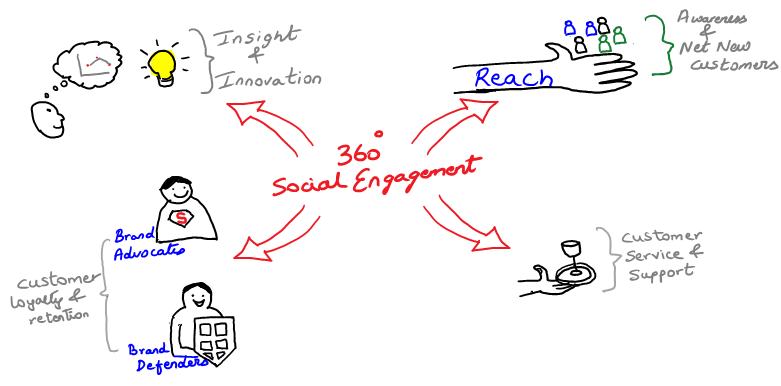8 Psychology Hacks to Improve Your Social Engagement
November 10, 2015 By rightly No comments yet small business, Social Engagement
Social media is simple. You craft your posts, share them with your followers and people will flock to your page eager to engage, right? That is the fantasy of every small business owner before getting started.
Their excitement drops when they aren’t seeing the results they were hoping for despite their constant updates. Most of them will give up social media entirely, missing out on a huge audience (there are over 2 billion social media accounts).
Reality check: people don’t go to Twitter or Facebook thinking that they might end up buying something. They are looking for something fun, interesting and temporal. They don’t want to hear about your products and they will ignore your advertisements.
To increase social engagement, you need to create content that is relevant, personal and easy to digest.
How can you make your social media posts more engaging? Use these 8 psychology-backed hacks.
- Evoke Strong Emotions
A lot of marketers focus on the rational aspects of their products. They talk about facts, numbers or features. But, it’s not the facts that get people to connect with your posts, but the emotions you evoke.
Studies in neuroscience have shown that there are four basic human emotions: sadness, happiness, anger and fear. Each one influences people in different ways. Happiness, for example, is the emotion that makes people want to share. An analysis of 10,000 of the most shared stories, cited by Hootsuite.com, found that the articles more likely to be shared were the ones evoking a positive feeling, like awe, laughter or amusement.
When crafting your social posts, focus on sharing content that is positive. Portray a happy, friendly and generous brand, and people will be drawn to you.
- Pique Curiosity
Humans have a deeply curious nature. When they hear a question, they can’t help but think of an answer. This is why the concept of the “curiosity gap” works so well in social media marketing. When the brain notices that a part of the information is missing, it produces a feeling of deprivation. As a result, people read the ad or click a link to complete their knowledge and stop the feeling of deprivation.
However, curiosity requires some sort of initial knowledge. People are not curios about the things they don’t know. But, as soon as they know even a little bit, their curiosity is triggered and they want to learn more.
The language you use in your social media updates can trigger your followers’ natural desire to learn more. Tell your followers enough to pique their curiosity, but not enough to give away the entire story.
- Use Image Psychology
It’s a well-known fact that people respond better to visual information than text. In fact, brains can process visual information 60.000 times faster than they can process text. So, there’s no wonder images can boost social engagement.
According to statistics, images receive 53% more likes on Facebook than the average post and 84% more link clicks. You can write amazing copy and have a powerful call to action, but if the image is dull, you most likely won’t see any significant results.
Use close-ups of faces that resemble your target audience. Also, use images of people facing to the right side. Users are likely to follow this directional cue and read your copy.
You can also use text images to support your copy. Just make sure the text in the image is clear and readable. Don’t use flashy colors or weird fonts.
- Make FOMO Work for You
Fear of missing out, or FOMO for short, is characterized as a perpetual fear of having made the wrong decision on how to spend time.
You can use this fear to encourage social engagement. Creating a sense of urgency is one of the tactics you can use to spur interactions. Use time-sensitive words, such as “Now”, “Today” or “Instantly” to make your followers feel like they will miss out on something if they don’t take immediate action. Give limited access to influence them to join a conversation and to encourage them to share your content.
- Ask Questions
Asking questions is a great way to spark dialogue with your followers. It is probably the easiest and most effective way to get users to respond to your updates.
You can ask a thought-provoking question to get people thinking and to engage them in a conversation. Or you can keep it simple by asking a Yes or No or True or False question.
- Employ the Power of Self-Perception
Self-perception theory affirms that people develop attitudes based on their own behavior. For example, if you go rock climbing for a few times, you will probably decide that you are passionate about this sport. So, you will act in a way that emphasizes your identity as a rock climber. You’ll search information about rock climbing and engage in conversation with people who share the same interest as you.
On social media, people will share content that is in tune with their self-perception. For example, poker players will share content related to poker because it reinforces their self-perception.
To increase social engagement, it is important to know how your followers identify themselves and create content that fits with their vision.
- Keep It Simple
To trigger social engagement, try to keep your messages short and simple. On Twitter this is fairly easy since you don’t have another choice but to fit your message into 140 characters.
According to Buffer.com, the ideal length of a Facebook post is less than 40 characters. One study by BlitzLocal found that question posts between 100 to 119 characters get more engagement than longer posts.
This isn’t to say that you should make every update as short as possible. But, you need to make sure you use short paragraphs to move readers’ eyes down the page.
- Use Trigger Words
To increase even more social engagement, start your posts with words that trigger action. Copyblogger’s Gregory Ciotti researched the five most persuasive words in the English language and found that people are more likely to react when they hear these terms:
- You
- Free
- Because
- Instantly
- New
These words trigger an emotional response that grab’s every person’s attention.
What Are You Doing to Improve Your Social Engagement?
Social media goes well beyond regular posts and update. For example, if you offer hairdressing services, chances are your audience wants to know about upcoming season trends or tips for healthier hair.
Use social media as an opportunity to connect with your audience and to expand your small business. Take time to listen to your followers and spark dialogues with them and social engagement will follow.
Have you tried any of these psychological hacks to improve your social engagement? What other tricks do you use to appeal to your followers?






Leave A Comment